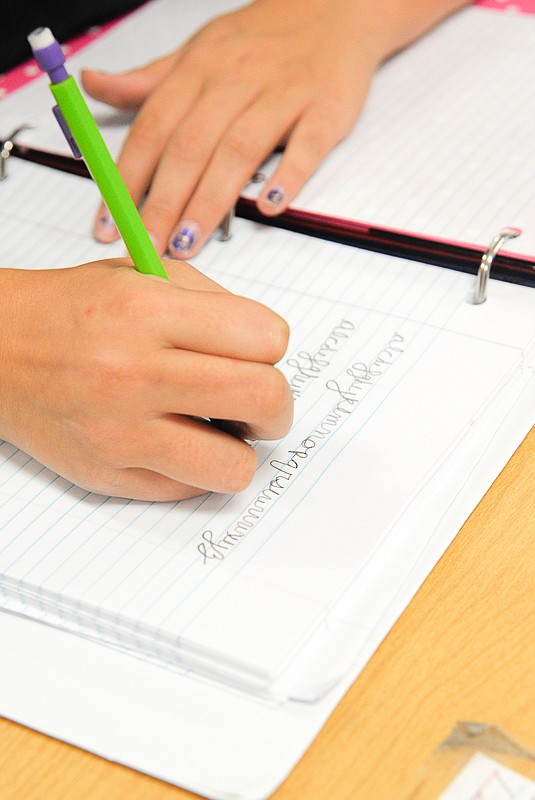Some schools have replaced handwriting minutes in the early elementary years with computer access.
But other schools see it as a lifelong skill - for official signatures and reading older, script documents, like the U.S. Constitution.
Handwriting has never been part of the Missouri Department of Elementary and Secondary Education's standards, said spokesperson Sarah Potter. And assessment testing now is entirely electronic.
"Writing, like many skills in education, is a changing skill. It's a local school district decision on when, how much or if they teach it," Potter said.
Because of the shift toward computer literacy, many schools, like California Elementary School, have eliminated cursive instruction all together to allow more time for keyboarding and computer basics.
"Cursive is dying; we don't teach it," said California Elementary Principal Daniel Williams. "When it's not something required, it's hard to spend much time on it.
"We do teach it as writing, like Egyptian hieroglyphics, as our culture has evolved, it went out.
"In the day of written text, it was a necessity. Now, our kids type."
Williams added that with the state's shift to computerized testing, "keyboarding is essential."
Yet, several other local schools have committed to continuing cursive instruction.
"We're so technology driven," acknowledged Russellville middle school language arts teacher Gayla Spencer. "But there's lots of research for what's good about cursive writing."
Spencer said Russellville teachers incorporate cursive instruction with grammar lessons to not use up too much curriculum time.
"As a school building, we're focused on writing this year," Spencer said.
The act of making cursive script, versus print writing or typing, has cognitive advantages, Spencer said.
Cursive helps struggling readers see words instead of individual letters. The flow of connected letters while writing cursive also encourages fluency and may contribute to the school's improved reading MAP scores, Spencer said.
"I've taught 25 years and have seen the difference it makes," she said. "I feel like it helps students make a connection between reading and writing, seeing the development of the words on paper."
Spencer referred to the article "Brain research and cursive writing" by special education teacher, David Sortino, May 22, 2013, in The Press Democrat.
Sortino said cursive writing has proved effective for higher SAT scores, those who printed had slightly lower scores. He suggested the speed and efficiency of writing cursive helps students compose their ideas.
"Rand Nelson of Peterson Directed Handwriting said the act of physically gripping a pen or pencil and practicing the swirls, curls and connections of cursive handwriting activates parts of the brain that lead to increased language fluency," Sortino wrote. "... Cursive writing acts as a building block rather than as a stressor."
In addition to the cognitive benefits, Spencer said she simply wants her students to be able to read script, such as the nation's founding documents, and they need to have an identifiable signature.
Before students knew cursive, the original U.S. Constitution "looked like a foreign language," she said. "Once they can write it, they can read it."
Russellville sixth grader Whitney Pavely said her goal is to learn cursive well enough to read the entire Constitution.
"I like cursive; it can be faster to write," Pavely said. "And it's easier to read sometimes ... because of the spaces between the words."
The Russellville sixth-grader also said she thinks cursive writing will not lose its importance.
"We need to have something to fall back on, if technology would fail," Pavely said.
Renee Phillips, third- and fourth-grade teacher at Clarksburg K-8 school, also teaches cursive, requiring a daily full-page journal entry. And in the second semester, cursive is required on all assignments.
Phillips agreed she has seen advantages from the use of cursive writing - neater work, thinking first before writing and improved concentration.
"At our small school, we focus quite a bit on keyboarding skills because of the new state assessment testing now being done completely on the computer," Phillips said. "So, keyboarding is a must. Technology is wonderful and it is utilized at our school a lot, but a signature and good brain function will always be needed!
"Until I retire, cursive handwriting will always be taught and used in my classroom. I think some educational people, teachers, administrators, etc., have lost some common sense when talking about certain subjects. Manners, social skills and good handwriting will always be needed. Too many kids are losing some of the basics, when we forget that they are still human, not computers."

